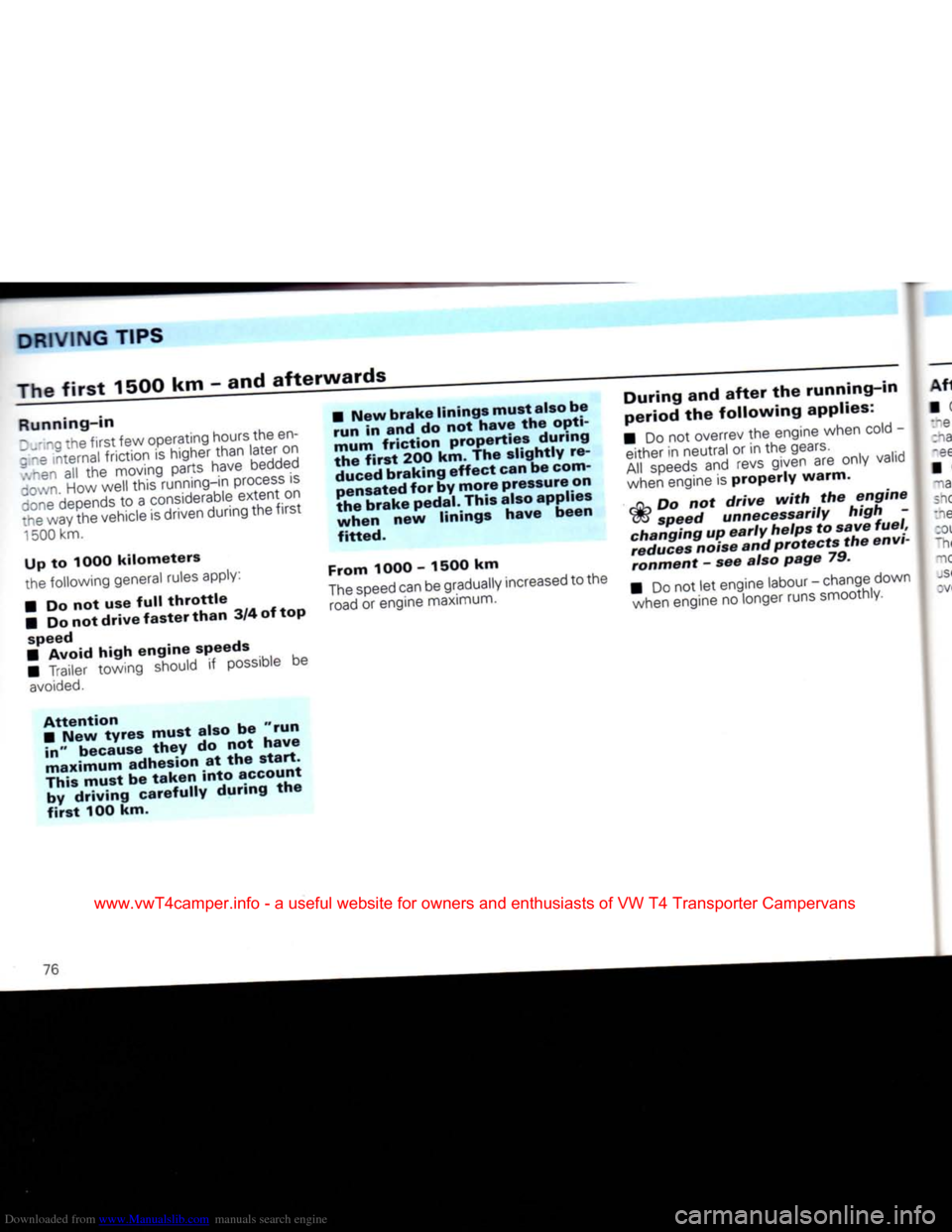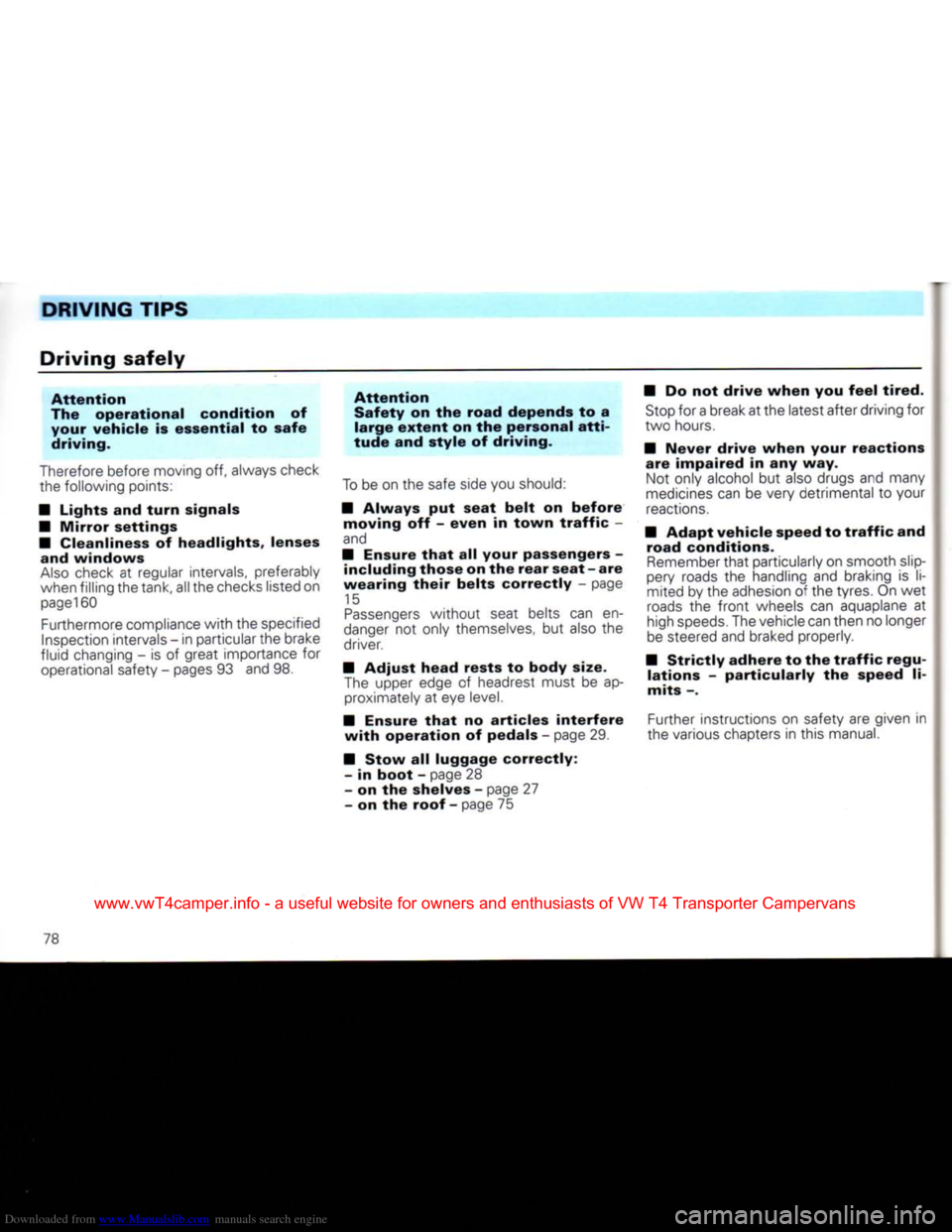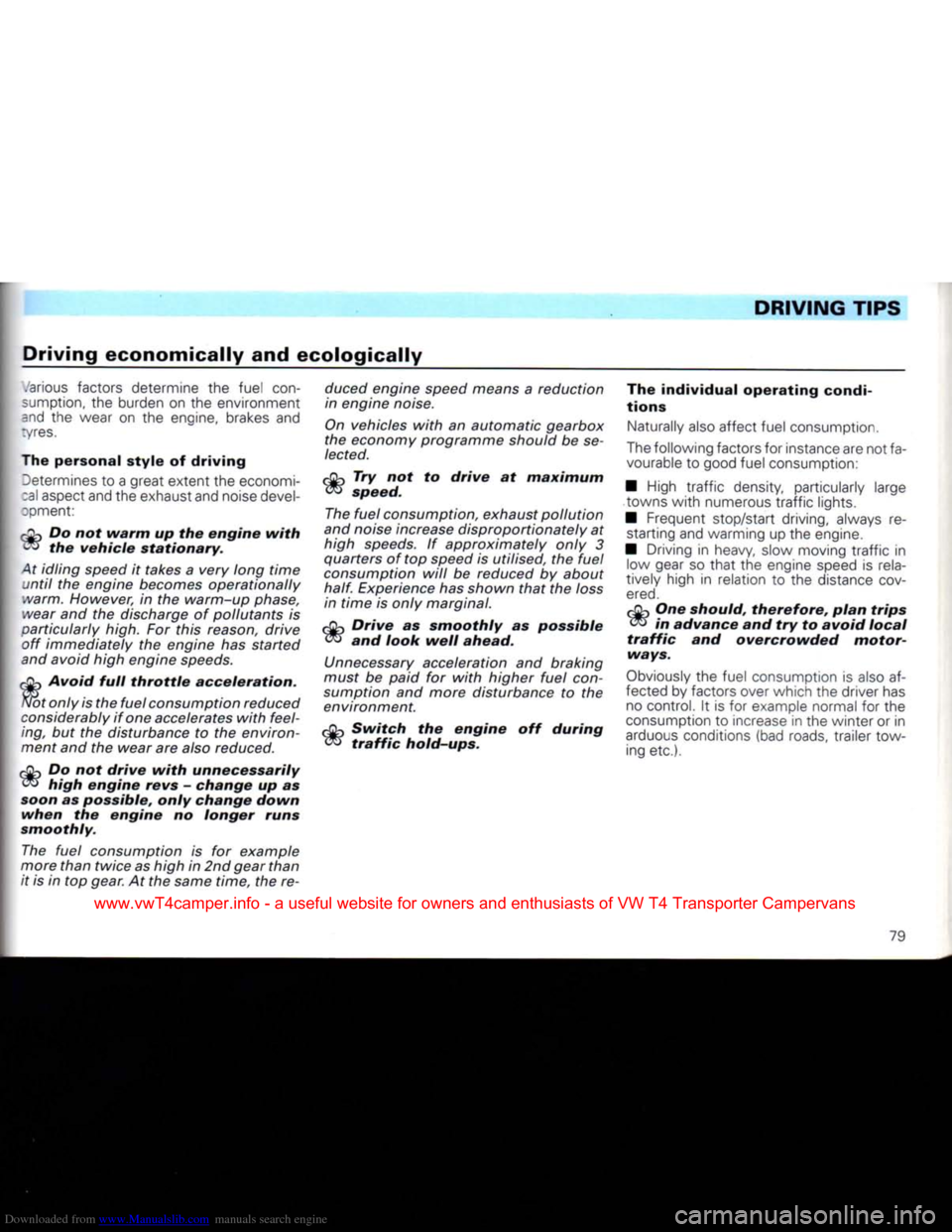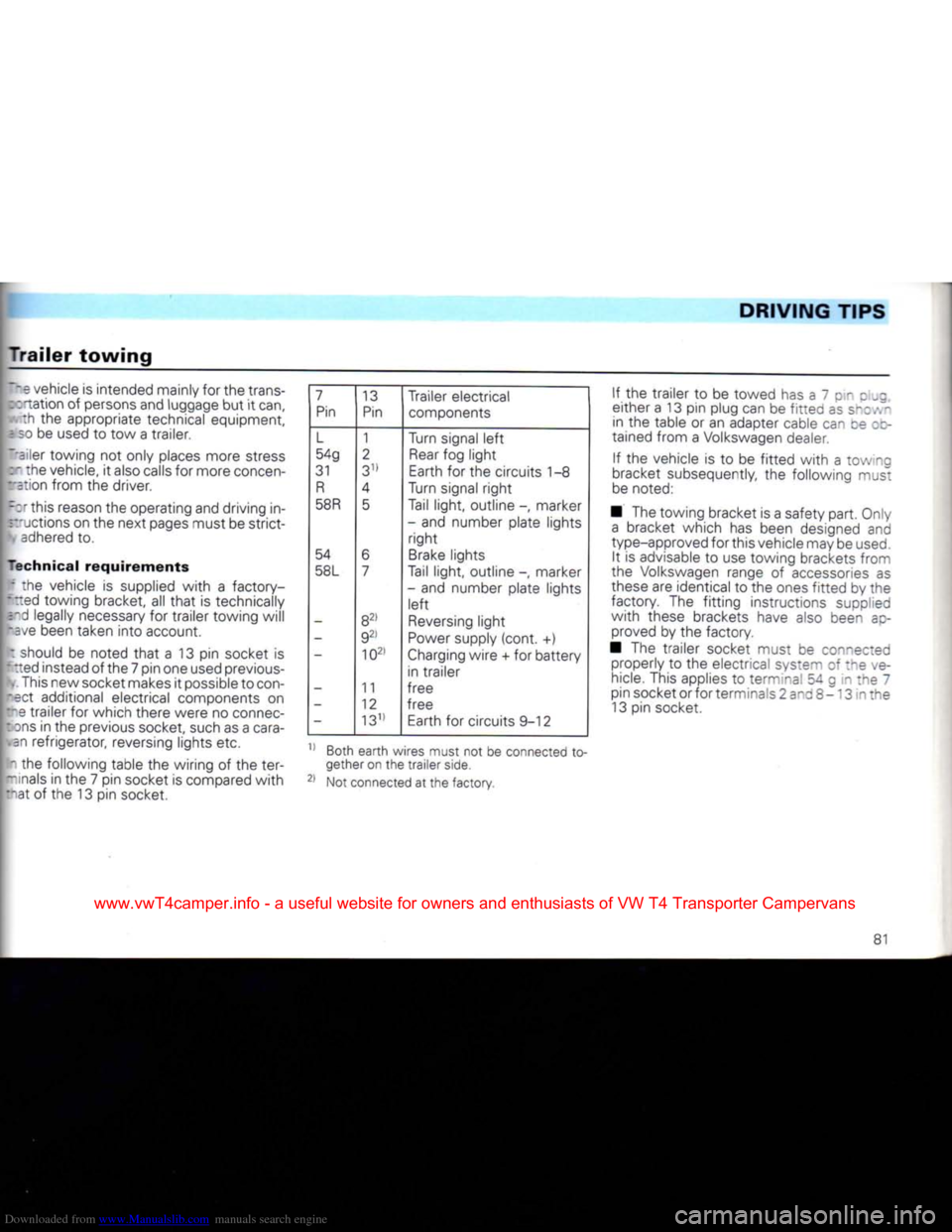1992 VOLKSWAGEN CARAVELLE brake light
[x] Cancel search: brake lightPage 50 of 164

Downloaded from www.Manualslib.com manuals search engine
CONTROLS
AND EQUIPMENT
The
warning lamp flashes when ignition is
switched
on. the lamp must go out when
engine
has started.
If the warning lamp does not go out or
flashes
when driving - a buzzer also sounds
at engine speeds above 2000 rpm - stop,
switch
engine
off, check oil level and if
necessary,
add oil - see page 97.
If the lamp comes on although the oil level
is
in order, do not
drive
on. Do not even
run the engine at idling speed-call in expert
assistance.
Note
The oil pressure
warning
lamp
is not an oil
level
indicator.
The oil
level
should
therefore
be checked at reg
ular
intervals,
preferably
every
time
the
fuel
tank
is filled.
3 -
High
beams 10 4 - Turn signals
The
warning lampflashes when
turn
signals
are
switched on. If a
turn
signal fails, the
warning lamp flashes twice as fast. (Not
when towing a trailer).
Further
details are given on pages 49
and
52. 5 -
Brake
system «^
The
warning lamp comes on when
• the handbrake is on
• the brake fluid level is too low
The
ignition must be switched on.
Attention
If the
lamp
does not go out
when
handbrake
is released or comes
on
when
driving, the
fluid
level
in
the reservoir is too low. If an in crease in
pedal
free
travel
is no
ticed
at the same
time,
one of the
brake
circuits may
have
failed.
You can
drive
on
carefully
to the
nearest
Volkswagen
dealer
but
allow
for
higher
pedal
pressures and longer
braking
distances on
the way.
The
warning lamp comes on when high
beams
are on or when the headlight flasher
is
used.
48
www.vwT4camper.info - a useful website for owners and enthusiasts of VW T4 Transporter Campervans
Page 51 of 164

Downloaded from www.Manualslib.com manuals search engine
CONTROLS
AND
EQUIPMENT
6-Alternator
Q
~ne warning lamp comes on when the
igni-
I
on
is
switched on and must go out when
She
engine
is
started.
i the warning lamp comes on when driving,
stop,
switch
engine
off
and
check
the
alternator V-belt.
f the V-belt
is
broken or loose do not
drive
on with
a
vehicle which
has a 4 cylinder
engine
because the coolant pump
is
then
no
longer being driven. The V-belt must
be
tensioned
or
renewed.
ehicles with
a 5
cylinder engine
can
nor
mally
be
driven to the nearest Volkswagen
dealer when
the
V-belt
is
broken
or
loose oecause
the
coolant pump
is
driven separ
ately but then the battery will discharge
con
tinuously
and all
non-essential electrical consumers should
be
switched
off.
f the warning lamp comes on although
the
belt
is
not broken, one can normally drive on
to
the nearest Volkswagen dealer (all engine
types)
but the
battery will then discharge
continuously
- see
previous paragraph.
7-Glow
plugs
W
(Diesel engines only)
When
the engine
is cold
the warning lamp comes on when key
is
turned to Drive
posi
tion
(ignition on).
If
the warning lamp does not come
on,
there
is
a
defect in the glow plug system
-
call
in
expert assistance.
When
the
lamp goes out,
start
the engine
immediately
-
see page
38.
When
the
engine
is warm the
glow plug
lamp
does
not
come on -the engine can
be
started straight
away.
(®)
-
Anti-locking
Brake
System
(ABS)*
The operational readiness
of the
essential electrical components
of the ABS are
checked,
both before moving off and when
driving,
by an electronic monitoring system.
The warning lamp lights up when
the
igni
tion
is
switched on and
it
must go out again, at the latest, after the engine
has
started.
If
the warning lamp does not go out
or if it
comes on when driving the system
is
not
in
order.
The
vehicle can then only
be
braked
with
the
normal system
-
that
is
without
ABS-.The vehicle must be taken to a Volks
wagen Dealership
as
soon
as
possible.
Further details on ABS
is
given on page
30.
<]1i>
-
Trailer
turn
signals
The warning lamp
*
flashes when turn
sig
nals are switched on when towing
a
trailer.
If a
turn signal fails on the trailer or vehicle,
the warning lamp does not flash.
www.vwT4camper.info - a useful website for owners and enthusiasts of VW T4 Transporter Campervans
Page 78 of 164

Downloaded from www.Manualslib.com manuals search engine
DRIVING
TIPS
The
first
1500 km - and
afterwards
Running-in
I/-c :he
first
few operating hours the en-
5ine
internal friction is higher than later on .-.hen all the moving parts have bedded
down.
How well this running-in process is
::cne
depends to a considerable extent on
the way the vehicle is driven during the
first
1500
km.
Up to 1000
kilometers
the following general rules apply:
• Do not use
full
throttle
• Do not
drive
faster
than
3/4 of top speed
• Avoid
high
engine
speeds
• Trailer towing should if possible be
avoided.
Attention
• New
tyres
must
also be "run in" because
they
do not
have
maximum
adhesion at the
start.
This
must
be
taken
into
account by
driving
carefully
during
the
first
100 km. • New
brake
linings
must
also be
run in and do not
have
the opti
mum
friction
properties
during
the
first
200 km. The
slightly
re duced
braking
effect
can be com
pensated
for by
more
pressure on
the
brake
pedal. This also applies
when
new linings
have
been
fitted.
From 1000 - 1500 km
The
speed can be gradually increased to the road or engine maximum.
During
and
after
the
running-in
period
the
following
applies:
• Do not overrev the engine when cold - either in neutral or in the gears.
All
speeds and revs given are only valid
when engine is
properly
warm.
Do not
drive
with
the
engine
speed
unnecessarily
high
changing
up
early
helps
to
save
fuel,
reduces
noise
and
protects
the
envi
ronment
- see
also
page
79.
• Do not let engine labour - change down when engine no longer runs smoothly.
76
www.vwT4camper.info - a useful website for owners and enthusiasts of VW T4 Transporter Campervans
Page 80 of 164

Downloaded from www.Manualslib.com manuals search engine
DRIVING
TIPS
Driving
safely
Attention
The
operational
condition of your
vehicle
is
essential
to
safe
driving.
Therefore before moving off, always check
the following points:
• Lights and
turn
signals
•
Mirror
settings
• Cleanliness of
headlights,
lenses and
windows
Also
check at regular intervals, preferably
when filling the tank, all the checks listed on
page160
Furthermore compliance
with
the specified Inspection intervals - in particular the brake
fluid changing - is of great importance for operational safety - pages 93 and 98.
Attention
Safety
on the
road
depends to a
large
extent
on the personal
atti
tude
and
style
of driving.
To
be on the safe side you should:
•
Always
put
seat
belt
on
before
moving
off -
even
in
town
traffic
-
and
• Ensure
that
all your passengers - including
those
on the
rear
seat
- are
wearing
their
belts
correctly
- page
15
Passengers
without seat belts can en
danger
not only themselves, but also the
driver.
•
Adjust
head
rests
to body size.
The
upper edge of headrest must be approximately at eye
level.
• Ensure
that
no
articles
interfere
with
operation
of pedals - page 29
•
Stow
all
luggage
correctly:
- in
boot
- page 28
- on the shelves - page 27
- on the
roof
- page 75 • Do not
drive
when
you
feel
tired.
Stop
for a break at the latest after driving for
two hours.
•
Never
drive
when
your
reactions
are
impaired
in any way. Not only alcohol but also drugs and many
medicines
can be very detrimental to your
reactions.
•
Adapt
vehicle
speed to
traffic
and
road
conditions.
Remember
that
particularly on smooth slip
pery roads the handling and braking is li
mited by the adhesion of the tyres. On wet
roads
the
front
wheels can aquaplane at
high
speeds.
The vehicle can then no longer
be
steered and braked properly.
•
Strictly
adhere
to the
traffic
regu
lations
-
particularly
the speed li
mits
-.
Further instructions on safety are given in
the various chapters in this manual.
78
www.vwT4camper.info - a useful website for owners and enthusiasts of VW T4 Transporter Campervans
Page 81 of 164

Downloaded from www.Manualslib.com manuals search engine
DRIVING
TIPS
Driving economically and ecologically
.'arious
factors determine the fuel
con
sumption,
the burden on the environment
and
the wear on the engine, brakes and
lyres.
The personal style of driving
Determines
to a great extent the economi-
:al
aspect and the exhaust and noise
devel
opment:
jOp
Do not
warm
up the
engine
with
W» the
vehicle
stationary.
At idling speed it takes a very long
time
until
the engine becomes operationally
warm. However, in the warm-up phase,
wear and the discharge of pollutants is
oarticularly high. For
this
reason, drive
off immediately the engine has started
and avoid
high
engine speeds.
f
h Avoid
full
throttle
acceleration.
of only is the
fuel
consumption reduced
considerably
if one accelerates
with
feel
ing, but the disturbance to the environ
ment
and the wear are also reduced.
rflri
Do not
drive
with
unnecessarily
high
engine
revs
-
change
up as
soon as possible,
only
change
down
when
the
engine
no
longer
runs
smoothly.
The
fuel
consumption is for example
more
than
twice as
high
in 2nd gear
than
it is in top
gear.
At the same
time,
the re duced engine speed means a reduction
in engine noise.
On vehicles
with
an automatic gearbox
the economy programme should be se
lected.
c^p
Try not to
drive
at
maximum
TO
speed.
The
fuel
consumption, exhaust pollution
and noise increase disproportionately at
high
speeds. If approximately only 3
quarters of top speed is utilised, the
fuel
consumption
will
be reduced by about
half.
Experience has shown
that
the loss in
time
is only marginal.
c
j-,
Drive
as
smoothly
as possible and
look
well
ahead.
Unnecessary
acceleration and braking
must
be paid for
with
higher
fuel
con
sumption and more disturbance to the environment.
Switch
the
engine
off
during
hold-ups. The individual
operating
condi
tions
Naturally
also
affect fuel consumption.
The
following factors for instance are not fa
vourable
to good fuel consumption:
•
High traffic density, particularly large
.towns with numerous traffic lights.
•
Frequent stop/start driving, always restarting and warming up the engine.
•
Driving in heavy, slow moving traffic in
low
gear so that the engine speed is
rela
tively high in relation to the distance cov
ered.
CQ~, One
should,
therefore,
plan
trips
in
advance
and try to
avoid
local
traffic
and
overcrowded
motor
ways.
Obviously
the fuel consumption is
also
af
fected
by factors over which the driver has
no
control. It is for example normal for the
consumption
to increase in the winter or in
arduous
conditions (bad roads, trailer tow ing etc.).
79
www.vwT4camper.info - a useful website for owners and enthusiasts of VW T4 Transporter Campervans
Page 83 of 164

Downloaded from www.Manualslib.com manuals search engine
DRIVING
TIPS
Trailer
towing
~~e
vehicle is intended mainly for the trans-
cctation of persons and luggage but it can, th the appropriate technical equipment,
=
so be used to tow a trailer.
Ibiler towing not only places more stress : - the vehicle, it also calls for more concen-
ration from the driver.
::r this reason the operating and driving inductions on the next pages must be strict- . adhered to.
Technical
requirements
" :he vehicle is supplied
with
a factory-
• ::ed towing bracket, all
that
is technically -
d
legally necessary for trailer towing will =ve been taken into account.
: should be noted
that
a 13 pin socket is
::ed
instead of the 7 pin one used previous- . This new socket makes it possible to con-
ect additional electrical components on trailer for which there were no connec-
ns
in the previous socket, such as a
cara-
n refrigerator, reversing lights etc.
the following table the wiring of the ter-
nals
in the 7 pin socket is compared
with
at of the 13 pin socket.
I a 7
13
Trailer electrical
Pin Pin
components
L
1 Turn signal
left
54g
2
Rear
fog light
31
311
Earth
for the circuits 1-8
R
4
Turn signal
right
58
R
5
Tail
light, outline -, marker
- and number plate lights
right
54 6
Brake
lights
58L
7
Tail
light, outline -, marker
- and number plate lights
left
- 82>
Reversing
light
-
92!
Power
supply (cont. +)
-
102!
Charging
wire + for battery
in trailer
- 11
free
- 12
free
-
1311
Earth
for circuits 9-12
1) Both earth wires must not be connected to gether on the trailer side.
21 Not connected at the factory. If the trailer to be towed has a 7 pin plug,
either a 13 pin plug can be
fitted
as shown
in the table or an adapter cable can ce zz-
tained from a Volkswagen dealer.
If the vehicle is to be
fitted
with
a towing
bracket subsequently, the following must
be
noted:
• The towing bracket is a safety part. Only
a
bracket which has been designed and
type-approved for this vehicle may be
used.
It is advisable to use towing brackets from
the Volkswagen range of accessories as
these
are identical to the ones
fitted
by the
factory. The
fitting
instructions supplied
with
these brackets have also been ap proved by the factory.
• The trailer socket must be connected properly to the electrical system of the ve
hicle.
This applies to terminal 54 g in the 7
pin socket or for terminals 2 and 8 -13 in the
13
pin socket.
81
www.vwT4camper.info - a useful website for owners and enthusiasts of VW T4 Transporter Campervans
Page 85 of 164

Downloaded from www.Manualslib.com manuals search engine
DRIVING
TIPS
• Where possible make
full
use of the maximum permissible drawbar weight on
call
of the towing bracket - see page 151 -
cut do not exceed it.
• While observing the permissible trailer
and
drawbar weight, distribute the load in
the trailer so
that
heavy objects are as near
as
possible to the axle. The objects must
a
so be secured so
that
they cannot slip
aoout.
• Check the
tyre
pressures on the towing
/ehicle
and the trailer.
• The headlight settings, should be
:hecked
with
trailer attached before mov- ng off and adjusted as necessary.
On
vehicles
with
headlight beam control it
is
only necessary to
turn
the knurled disc in
:ash
in the appropriate direction.
Driving
instructions
To
obtain the best possible handling of ve
hicle
and trailer, the following should be
noted:
• Try to avoid driving
with
an unladen ve
hicle
and a loaded trailer. If this cannot be
avoided,
only drive slowly to allow for the unfavourable weight distribution.
• As driving stability of vehicle and trailer
decreases
when the speed increases do not
drive at the maximum permissible top
speed
in unfavourable road, weather or
wind conditions - particularly when going downhill. In any
case
the speed must be reduced im
mediately the trailer shows the slightest
sign
of snaking. On no account try to stop
the snaking by accelerating.
• For safety reasons one should not drive faster than 80 km/h (50 mph). This also
applies
in countries where higher speeds
are permitted. • Always brake in good time. If the trailer
has
an overrun brake, apply the brakes gen
tly at
first
then firmly. This will avoid the
jerk
ing caused by the trailer wheels locking.
Change
down before going down a steep hill so
that
the engine can act as a brake.
• When a long climb in a low gear
with
ex tremely high engine revs must be nego
tiated at exceptionally high ambient temperatures the coolant temperature gauge must be observed. When the gauge needle
moves
to the
>~zza'
e~z of :ne
scale,
the road speed must be reduced immediately. If nevertheless ~g amp flashes,
stop immediately and si ow the engine to
cool
off at idling speed for several minutes.
• The cooling effect of the radiator fan
can
not be increased by changing down, be
cause
the speec of t~e
~a~
s ~o! dependent
on the engine
speed.
One should therefore not change down even when towing a
trailer as long as :-e e-g -e zar cope with out the vehicle speed dropping too much.
83
www.vwT4camper.info - a useful website for owners and enthusiasts of VW T4 Transporter Campervans
Page 107 of 164

Downloaded from www.Manualslib.com manuals search engine
GENERAL
MAINTENANCE
'necking fluid level
Pe :orrect fluid level is essential to the sat-
:~=
:tory operation of the brake system. The
fc. Z level must always be between the
AX"
and "MIN" marks.
~- a "evel of fluid tends to sink slightly when
"a vehicle is used due to the automatic ad- ::ment of brake linings. This is quite nor-
-rwever, if the level sinks noticeably in a
srorttime or drops below the "MIN" mark
re system may be leaking. A low fluid level " the reservoir is indicated by the brake
w.arning lamp lighting up (see page 48 also), .nen this happens take car to a Volks
wagen dealer immediately and have the
cake system checked. Renewing brake fluid
Brake fluid absorbs moisture. In the course
of time it takes in water from the ambient
air. Too high a content of water in the brake
fluid can in time cause corrosion damage in
the system. Furthermore the boiling point of
the brake fluid is reduced considerably. For
this reason the brake fluid must be renewed every two years.
Attention
When the brake fluid becomes
too old vapour bubbles can form in the brake system when the
brakes are used hard. The
effi
ciency of the brakes and thus the
vehicle safety is then seriously
affected.
Only use our genuine brake fluio (see: - ra
tion to US standard FMVSS 116 DO~-
.
~-e
fluid must be new.
Attention Brake fluid is poisonous!
It must therefore only be stored in the closed original container
out of reach of children.
Remember also that brake fluid will
attack the paintwork. Because of the disposal
prob
lems,
the special tools necessary
and the specialist knowledge re
quired,
the brake fluid changing
should preferably be done by a
Volk
swagen
dealer.
It is advisable to have the fluid change car
ried out during an Inspection Service.
www.vwT4camper.info - a useful website for owners and enthusiasts of VW T4 Transporter Campervans